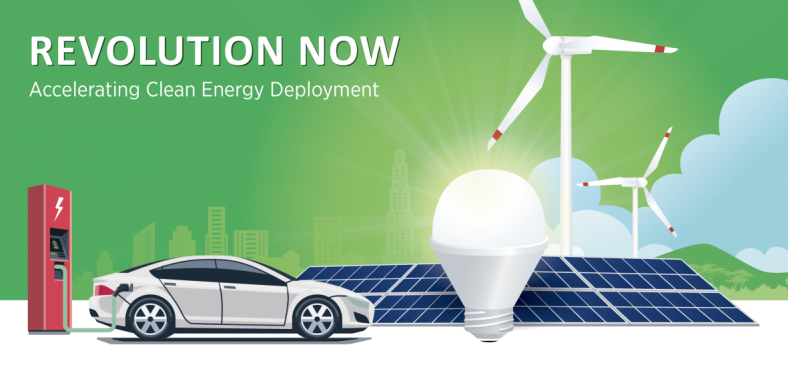by Brianna Crandall — October 7, 2016 — For facilities managers researching how some type of renewable energy may fit into their facilities’ energy portfolio, the U.S. Department of Energy (DOE) has released a new report that highlights the accelerated deployment of five clean energy technologies: wind turbines, solar technologies for both utility-scale and distributed photovoltaic (PV), electric vehicles (EVs), and light-emitting diodes (LEDs).
Revolution…Now, announced by Energy Secretary Ernest Moniz during a discussion at The Atlantic’s Washington Ideas Forum, is annually updated and describes the decreasing cost and increasing deployment of clean energy technologies in the United States. As the world continues to move toward a low-carbon economy, this 2016 update builds upon last year’s edition and details the economic and environmental benefits the nation is already starting to realize thanks to the increased deployment.

The annual update on clean energy technologies describes the decreasing cost and increasing use of wind, utility-scale and distributed PV solar, electric vehicles and LEDs.
DOE’s continued investments in the research and advancement of the five clean energy technologies highlighted in Revolution…Now have reportedly contributed to price reductions from 40% to as high as 94% since 2008. Highlights from the report detail the dramatic increases in America’s clean energy deployment, which include:
- Land-based wind accounted for 41% of all new capacity brought online in 2015. Overall, wind generated enough electricity to power more than 17 million households.
- Utility-scale solar PV represented 15% of all newly installed electricity generation capacity in 2015. Overall utility-scale PV generated enough electricity to power over 2 million homes.
- Distributed solar PV has reached one million rooftop installations on homes and businesses after experiencing a 54% reduction in overall costs since 2008.
- In total, wind and solar accounts for two-thirds of all new, U.S. installed electricity capacity.
- Installation of LED A-type bulbs exceeded 200 million through 2015 — growing 160% over 2014.
- Total sales of electric vehicles (EV) has soared closer to the half million mark, with 490,000 EVs on the road as of August 2016.
Increased deployment of clean energy technologies is already revealing real-time benefits, finds the report. Solar power saved 17 million metric tons of carbon dioxide (CO2) in 2014, leading to reduced water consumption and decreased air pollution that equate to nearly $700 million in environmental savings. LEDs use 85% less energy than incandescent bulbs, and projections show that increased installation could allow for up to $630 billion in energy savings for Americans between now and 2035.
In addition to these five rapidly growing clean energy technologies, the report also discusses four emerging technologies. These additional technologies — fuel cells, grid-connected batteries, energy management systems, and big area additive manufacturing, commonly known as 3-D printing — are on the cusp of wider deployment in the coming years. As these technologies become even more cost-effective and widely available, the economic and environmental benefits will grow.
DOE says it will continue its research and development for these core and emerging technologies as it works to further reduce market barriers and continue innovation that strengthen the clean energy revolution and transform the way in which the United States produces and uses energy.
DOE has made available on its Web site the full Revolution…Now report, as well as a short fact sheet and a video on the report.





